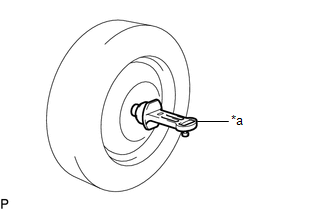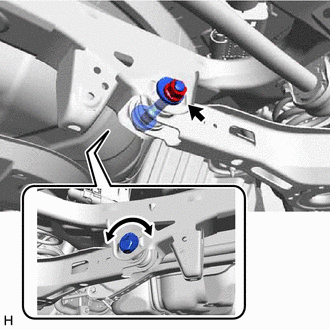Lexus ES: Adjustment
ADJUSTMENT
CAUTION / NOTICE / HINT
The necessary procedures (adjustment, calibration, initialization, or registration) that must be performed after completing the rear wheel alignment procedure are shown below.
Necessary Procedures After Procedure Performed| Replaced Part or Performed Procedure | Necessary Procedure | Effect/Inoperative Function when Necessary Procedure not Performed | Link |
|---|---|---|---|
| Rear wheel alignment adjustment | for HV Model:
|
| |
| for Gasoline Model:
|
| |
PROCEDURE
1. INSPECT TIRES
Click here .gif)
2. MEASURE VEHICLE HEIGHT
Click here .gif)
3. INSPECT CAMBER
NOTICE:
Inspect while the vehicle is unloaded.
| (a) Install a camber-caster-kingpin gauge. |
|
(b) Inspect the camber.
Camber (Unloaded Vehicle):
| Engine | Camber Inclination | Right-left Difference |
|---|---|---|
| 2GR-FKS | -1°10' +/- 0°45' (-1.17° +/- 0.75°) | 0°45' (0.75°) or less |
| A25A-FXS | -1°05' +/- 0°45' (-1.08° +/- 0.75°) |
HINT:
Camber is not adjustable. If the measurement is not within the specified range, inspect the suspension parts for damage and/or wear, and replace them if necessary.
4. INSPECT TOE-IN
NOTICE:
Inspect while the vehicle is unloaded.
(a) Bounce the vehicle up and down at the corners to stabilize the suspension.
(b) Release the parking brake and move the shift lever to N.
(c) Push the vehicle straight ahead approximately 5 m (16.4 ft.). (Step A)
(d) Put tread center marks on the rearmost points of the rear wheels and measure the distance between the marks (dimension B).
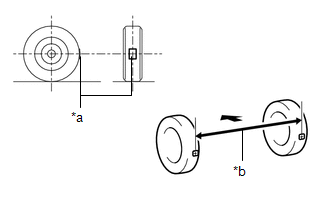
| *a | Tread Center Mark |
| *b | Dimension B |
.png) | Front of the Vehicle |
(e) Slowly push the vehicle straight ahead to cause the rear wheels to rotate 180°. Use the rear tire valve as a reference point.
HINT:
Do not allow the wheels to rotate more than 180°. If the wheels rotate more than 180°, perform the procedure from step A again.
(f) Measure the distance between the tread center marks on the front of the rear wheels (dimension A).
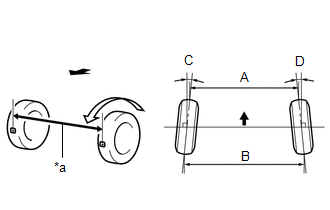
| *a | Dimension A |
.png) | Front of the Vehicle |
Toe-in (Unloaded Vehicle):
| Engine | Specified Condition | Right-left Difference |
|---|---|---|
| 2GR-FKS | C + D: 0°12' +/- 0°10' (0.20° +/- 0.17°) | - |
| B - A: 2.3 +/- 2.0 mm (0.0906 +/- 0.0787 in.) | 2.0 mm (0.0787 in.) or less | |
| A25A-FXS | C + D: 0°11' +/- 0°10' (0.19° +/- 0.17°) | - |
| B - A: 2.2 +/- 2.0 mm (0.0866 +/- 0.0787 in.) | 2.0 mm (0.0787 in.) or less |
HINT:
Measure "B - A" only when "C + D" cannot be measured.
If the toe-in is not within the specified range, adjust it at the rear suspension toe adjust cam sub-assembly.
5. ADJUST TOE-IN
| (a) Loosen the nut of the rear No. 2 suspension arm assembly (on the rear suspension member sub-assembly side). NOTICE: Hold the rear suspension toe adjust cam sub-assembly while rotating the nut. |
|
(b) Rotate the rear suspension toe adjust cam sub-assembly to adjust the toe-in.
Toe-in (Unloaded Vehicle):
| Engine | Specified Condition | Right-left Difference |
|---|---|---|
| 2GR-FKS | C + D: 0°12' +/- 0°10' (0.20° +/- 0.17°) | - |
| B - A: 2.3 +/- 2.0 mm (0.0906 +/- 0.0787 in.) | 2.0 mm (0.0787 in.) or less | |
| A25A-FXS | C + D: 0°11' +/- 0°10' (0.19° +/- 0.17°) | - |
| B - A: 2.2 +/- 2.0 mm (0.0866 +/- 0.0787 in.) | 2.0 mm (0.0787 in.) or less |
HINT:
- Rotating the rear suspension toe adjust cam sub-assembly by one notch changes the toe by approximately 2.6 mm (0.102 in.).
- Perform adjustments so that the value is as close as possible to the median of the specified range.
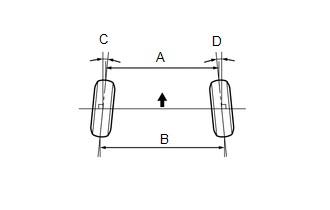
.png) | Front of the Vehicle |
(c) Tighten the nut of the rear No. 2 suspension arm assembly (on the rear suspension member sub-assembly side).
Torque:
100 N·m {1020 kgf·cm, 74 ft·lbf}
NOTICE:
Hold the rear suspension toe adjust cam sub-assembly while rotating the nut.
6. ALIGN FRONT WHEELS FACING STRAIGHT AHEAD
7. PERFORM YAW RATE AND ACCELERATION SENSOR ZERO POINT CALIBRATION (for HV Model)
Click here .gif)
8. PERFORM ACCELERATION SENSOR ZERO POINT CALIBRATION AND STORE SYSTEM INFORMATION MEMORIZATION (for Gasoline Model)
Click here .gif)

